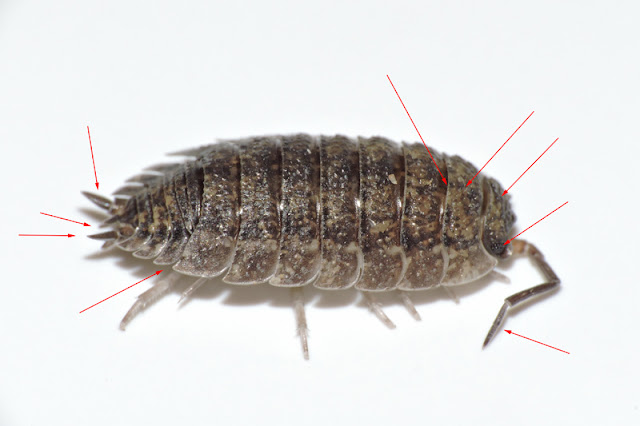Whilst sawflies and lacewings are much closer to my typical invert interests (six legs), woodlice are not really my cup of tea. At all. At home, and I have no idea when, why or how it started, we call them chiggypigs. I have seen most of the commoner species, and a few less common whilst out and about with Keith Lugg on PSL meet ups (and he certainly is interested in them). However the commoner ones have been identified by picture matching, and whilst I am sure they were correct it's always good to know why something is what it is.
I got home earlier than usual this afternoon, but not quite early enough to think about heading out to do something. So I decided to head into the garden, pot up differing woodlice and properly identify them with the key.
I actually ended up with five species, but I've not grabbed a shot of two (Rosy Woodlouse and Armadillidium depressum). Of the other three, all of which are common and widespread, two were very simple to key out:
Common Shiny Woodlouse (Oniscus asellus)
Following the key: uropods longer than wide (that's the extended bits at the back that look like flippers); antennal flagella with three sections; outline of edges of pereon and pleon a smooth line (the pereon is the front 7 segments, the pleon are the hind segments, and at the transition between these the outline is not stepped); prominent lobes on either side of the head. Dead easy.
Common Striped Woodlouse (Philoscia muscorum)
Again following the key: uropods longer than wide; antennal flagella with three sections; outline of pereon and pleon stepped; no lobes on sides of head; telson is pointed (the telson is the very last segment after the pleon); colouration such that there is a dark central dorsal stripe. Also straight forward.
So first two were easy to key in five / six couplets. The last one is also common but took a little bit more work.
Common Rough Woodlouse (Porcellio scaber)
Uropods longer than wide; antennal flagella with two segments; eyes with several ocelli; body pigmented; outline of pereon and pleon smooth; specimen not able to roll into a ball; dorsal surface covered in small raised bumps; uropods 'pear-shaped', widest about half way along; telson pointed at the tip; head colour similar to the body with no dark stripe; posterior margin of the first segment of the pereon more or less straight, not curved.
Always good when following keys for the first time comes up with the expected IDs. Before this little exercise I have never known the terms uropods, pereon, pleon and telson. I can see that there are some species where much closer scrutiny is required - like looking for lungs on the underside and checking the seventh leg, but next time I find some small woodlice whilst rummaging around I'll be more inclined to pot up a sample and have a go.





2 comments:
Just to throw a spanner in the works, Philoscia affinis has recently been shown to be relatively widespread in Britain (it's not in your Key). Go to the BMIG website and check their link for pics. But essentially, if your P.muscorum has a marbled/mottled head the same colour as the body - rather than much darker - check the 7th leg for affinis (males only). Some muscorum do have lighter heads, but affinis never has a blackish head. Best of luck!
Thanks Seth, think I'd seen that before but had completely forgotten. My garden has classic 'black with yellow spot' headed individuals, so I'm sure they are P. muscorum but it will be interesting to try and make sense of the 7th leg feature. Looks like no VC55 records of P. affinis so far, and no 'likely candidates' on the Naturespot website photos. Might be worth me looking for this in damp woodland this year.
Post a Comment